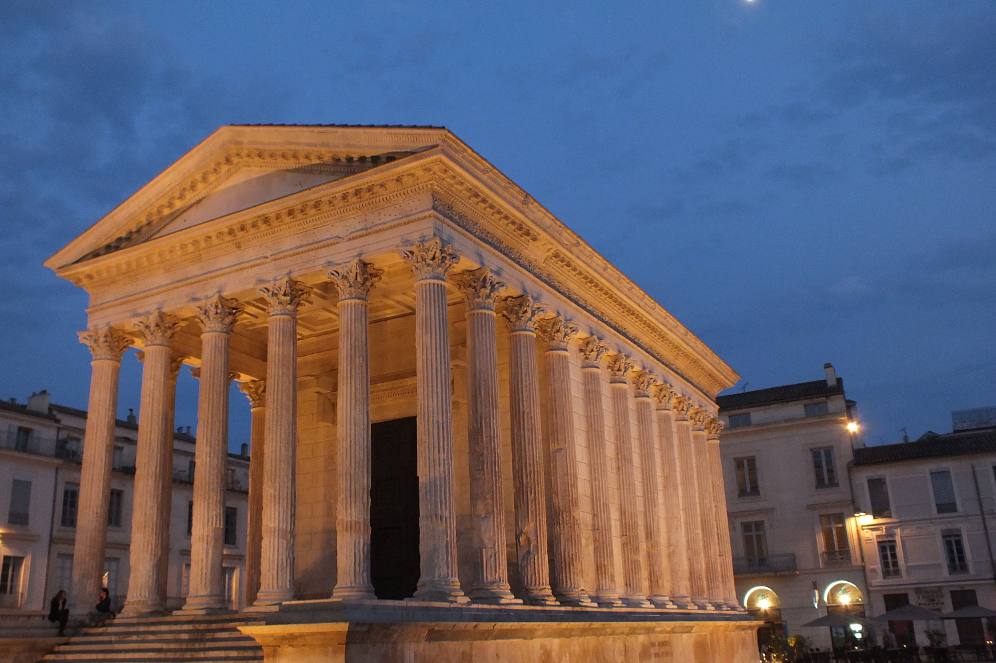
Roman France
A guide to the best Roman sites and monuments in France
- Explore France ►
- Essential pages
- Travel in France
- Where to go
- What to see and do
About-France.com
- the connoisseur's guide to France
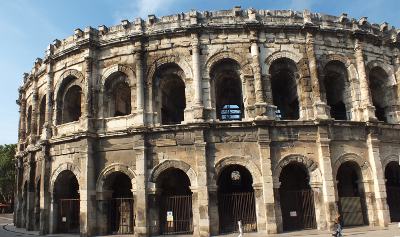
Roman arena - Nimes
Roman France
The Romans occupied France - or significant parts of it - for almost five hundred years. Julius Caesar launched his invasion of Gaul (what we now call France) in the year 58 BC; and the Romans eventually departed, or merged into the local population in the fifth century AD.Their presence played a determining role in the development of the French nations that followed. The language of the Romans, Latin, evolved into medieval French and later into modern French. Many of modern France's great cities - Paris, Lyon, Reims, Rennes, Marseille and others can trace their history back to Roman times if not earlier. The people who lived in Gaul in the 4th century and beyond have been long known as the Gallo-Romans (i.e. Gallic Romans) – an interesting contrast with the situation in Britain, where the equivalent population is referred to as Romano-British (i.e. Romanized Britons).
| On this page ► | Roman Provence | More sites in the south of France | Sites in the rest of France |
The finest and richest collection of Roman remains in France today is to be found in and around Provence. Indeed the name "Provence" is of Roman origin, as this area was the first province to be set up under the Roman empire. Roman "Provincia Gallia Narbonensis" stretched along most of the Mediterranean coast - much more than today's Provence - and its capital was for a long time the city of Narbonne, now in Languedoc.
Little of Roman Narbonne survives today; there is just a section of Roman road, and the Horreum, a system of underground cellers.
A trip round Roman Provence
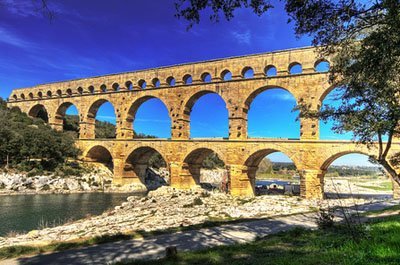
Pont du Gard, near Nimes
Places
to stay

Click
for best
online rates for hotels in or near the towns with the finest Roman
sites in France.
Nimes
Arles
Dijon
Orange
Lyon
Vaison
Autun
Saintes
Limoges
Poitiers
Reims
Besançon
Other areas
The
best place to admire the remains of Roman "Provincia Gallia
Narbonensis" - the best set of Roman remains in France - is the small
city of Nimes,
often called the Rome of France. Nimes boasts half a
dozen well preserved Roman sites, most importantly the Maison
Carrée
(photo top of page), a former temple; this is arguably the best
preserved Roman temple anywhere in the world. Nearby, the
Roman arena
is also very well preserved, and still regularly hosts events to this
day. Nimes also has two Roman
city gates, and, in the Jardins de la
Fontaine, a Temple of
Diana and a large watch tower, known as La Tour
Magne.
Arles
Dijon
Orange
Lyon
Vaison
Autun
Saintes
Limoges
Poitiers
Reims
Besançon
Other areas
About-France.com
is
partnered with Booking.com, to
bring you the best online prices
Nimes now also boasts a new state-of-the-art museum, the Musée de la Romanité, or Museum of Roman times, opened in 2018 and located right next to the Arena. Tickets available online ► here .
Twenty-five kilometres east of Nimes, beside the village of Remoulins, is another of the surviving wonders of the Roman world, the magnificent Pont du Gard aqueduct, the highest and best preserved aqueduct of the Roman world. The Pont du Gard is a big tourist attraction, complete with interpretive centre. Tickets available online ► here .
After Remoulins, it is 40 km drive to the small town of Saint Rémy de Provence: just outside Saint Rémy is a large archeological site covering the Roman city of Glanum. Little remains standing in Glanum, except the unusual mausoleum of the Julii, and a finely sculpted triumphal arch, both of which have finely preserved Roman sculptures.
From Saint Rémy, it is then another 25 km drive southeast to the town of Arles, on the banks of the Rhone. After Nimes, Arles has the best collection of Roman remains of anywhere in France, and notably its large and finely preserved Arena. Close to the arena is a Gallo-Roman theatre. Other Roman sites in Arles include the Alyscamps, a Roman necropolis, and remains of a Roman aqueduct.
From Arles, it is 35 km back to Nimes... or else spend another day or two visiting the Camargue.
One other interesting Roman site is the Pont Flavien, a Roman bridge with two triumphal arches. It is located at Saint Chamas, 40 km west of Aix en Provence.
Nearest airports for this trip : Nimes, Marseille/Provence, Montpellier.
More on Nimes
More Roman sites in the south of France
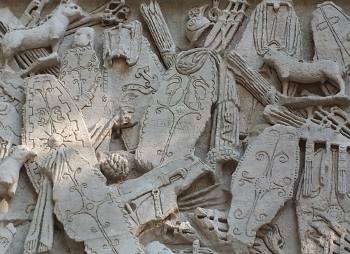
Fine Roman sculpture on the triumphal arch at Orange
There are three interesting Roman sites in the Vaucluse department
Orange (north of Avignon): This town has an impressive Roman theatre, used each year for the Orange opera festival, and a fine triumphal arch, standing in the middle of N7 road on the northern exit from the town.
Vaison la Romaine, northwest of Orange. Ruins of the Roman town, a 1st century AD Roman bridge and fine and well restored Roman theatre.
Also in the Vaucluse department, near Apt, the Pont Julien is a well-preserved Roman bridge where the old Via Domitia crossed the river Calavon.
Vienne (Isère, south of Lyon) : Gallo-Roman theatre, fine temple of Augustus and Livia, and Gallo-Roman pyramid.
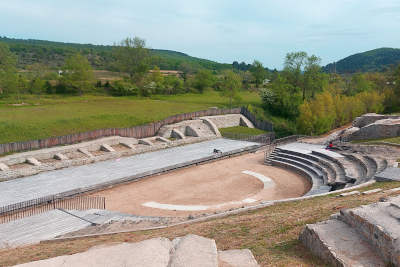
Amphitheatre, Alba la
Romaine
Lyon: Roman theatre and amphitheatre, on Fourvière hill, central Lyon.
The Romans appreciated the coastal area that is now known as the French Riviera. One location on the Riviera with an appreciable Roman heritage is Fréjus , which was an important port in Roman times and before. This town has the remains of a Roman aqueduct, a renovated Roman amphitheatre and the remains of a large Roman theatre. The archeological museum has Roman statues and mosaics.
Another stunning Roman monument is the Trophy of Augustus, standing above the village of La Turbie at the highest point of the former Via Julia Augusta, overlooking the Mediterranean near the Italian border.
The best Roman remains in other parts of France
Autun (Burgundy) Two impressive Roman city gates, kilometres of city walls, and the remains of one of the largest Roman theaters in Gaul. Also the remains of a Roman pyramid and a Temple of Janus.
Alesia (Burgundy) Interpretive centre with historic recreation of Roman defences on the site of the battle at which Julius Caesar conquered the Gauls.
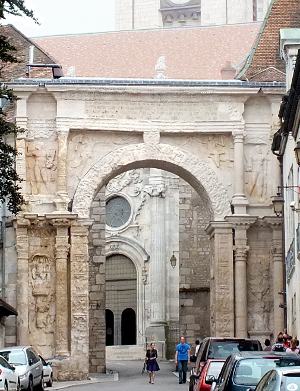
Besançon ; Roman arch, beside the cathedral
Le Mans, in the Pays de la Loire region, claims to have the longest Roman walls in France, but this is wishful thinking! These 4th century Roman walls are exceptional for their decorative stonework, and with some 500 metres still surviving, are among the longest in Europe. They are however far shorter than those of Autun (above), let alone the complete Roman walls of Lugo, in northwest Spain. Fifteen of the forty or so original towers are still standing.
Reims (Champagne) - A large Roman triumphal arch
Paris- Little of Roman Paris remains; but parts of Roman baths can be visited in and beside the Muée du Moyen Age, just off the Boulevard St. Germain in the Latin Quarter
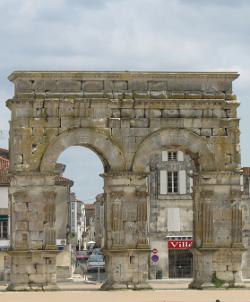 Saintes
(Charentes)
A fine double Roman arch, the Arch of Germanicus, and also a
large Roman amphitheatre..
Saintes
(Charentes)
A fine double Roman arch, the Arch of Germanicus, and also a
large Roman amphitheatre..About-France.com
Home
page - Site
search
- Regions
- Maps of France
- Contact
Photo top
of page
: Nimes,
Maison Carrée
Photo below : Glanum - Mausoleum of the Julii

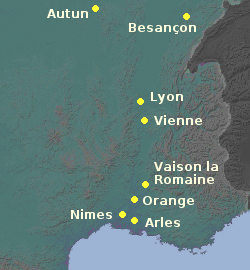
Main sites in historic Provence and eastern France
The
best of France
Text and photos copyright © About-France.com 2007 - 2025 except photo of Pont du Gard. Creative commons photo by W Staudt
Photo below : Glanum - Mausoleum of the Julii


Main sites in historic Provence and eastern France
The
best of France
by
theme
- Prehistoric France
- Roman France - the best sites
- Best medieval cathedrals
- Great medieval fortresses
- Renaissance and classic châteaux
- Loire
valley châteaux
- The best art galleries and museums in France
- Industrial and transport museums
- Living history museums (coming)
- Scenic railways and steam railways
- First world war sites and memorials
- The French coast and beaches
- Wine regions of France
- Beautiful villages in France
Click here for
low-cost car hire in France
low-cost car hire in France
Text and photos copyright © About-France.com 2007 - 2025 except photo of Pont du Gard. Creative commons photo by W Staudt
